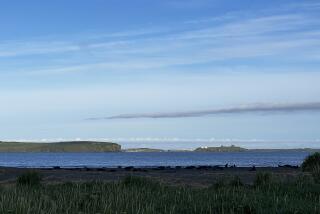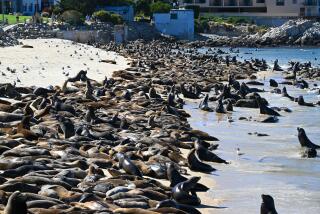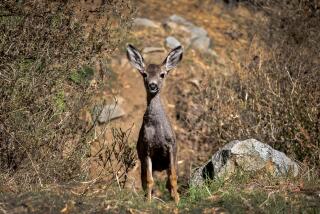Eagles Elude Capture by Helicopter
For the second time in three months, a cadre of golden eagles on Santa Cruz Island has outfoxed a helicopter crew trying to capture them, leaving frustrated wildlife managers to fall back on more traditional trapping methods.
The helicopter, aided by 20 spotters on the ground, spent the week chasing the powerful birds across steep ridges, into canyons and along sheer sea cliffs. But whenever the helicopter closed in, the eagles slipped away, ducking for cover beneath trees and ledges. The effort -- intended to help the endangered island foxes -- was finally called off Thursday.
Compounding the problem was the discovery that there are seven golden eagles on the island rather than the three recorded in July.
“One eagle managed to give birth and the others probably came from the mainland,” said Kate Faulkner, chief of resources management at Channel Islands National Park. “They are masterful fliers and can come across the channel with ease. They see other eagles circling above and think it’s good feeding territory.”
The birds are being removed from Santa Cruz, the largest of the Channel Islands, because they prey on the island fox. Many of the cat-sized foxes have been trapped and put in pens until the eagles are captured.
There are now 91 foxes living in captivity on Santa Cruz, Santa Rosa and San Miguel islands. The golden eagles nest on Santa Cruz but can roam to the other islands.
With the failure of helicopter trapping, park officials will return to bow nets, with which 22 golden eagles initially were caught starting in 1999 but which have since proved ineffective. The folding traps are baited with feral pig carcasses and buried. When hungry birds step into them, the traps snap shut.
Bow nets were abandoned after the last few birds, having watched others get gradually picked off, learned to avoid them.
Wildlife officials then borrowed a technique used in Wyoming. It involved chasing eagles with a helicopter until the birds tired and landed. The aircraft then hovers above, and a biologist perched in the door launches a net from what resembles a modified shotgun. Another crewman then leaps out and subdues the floundering animal.
But Santa Cruz Island, with plunging valleys and mountains rising to 4,000 feet, has proved more formidable than the open grasslands of Wyoming. Along with rugged terrain, foggy island weather has made helicopter netting almost impossible.
During the most recent effort, the helicopter closed in on an eagle that had landed. The net was fired, missing the bird by inches. The crew never got close again, park officials said.
“We are going back to the tried-and-true capture technique,” Faulkner said. “It should work on several of these birds that are immature. But it’s possible we may have to live with a small number of golden eagles on the islands.
“The real goal is to remove the feral pigs, their primary food source.”
After capture, the eagles, which can stand 3 feet high with wingspans of 8 feet, are transported 800 miles to Goose Lake in far northeastern California and released.
“We have to try every trick we have,” said Erik Aschehoug, project ecologist for the Nature Conservancy, which owns 76% of Santa Cruz Island. “We tried techniques used in other places and discovered they didn’t work here. We are going through all the steps in one of the largest environmental restoration efforts in the world.”
With so few eagles left, Aschehoug said there are discussions about whether to release the island foxes. He added that none of the 75 to 100 foxes in the wild on Santa Cruz have been killed by eagles in the last six months.
“We are feeling pretty good about this,” he said.
Removing golden eagles is part of the $5-million island restoration program aimed at eliminating nonnative species of plants and animals.
The biggest nuisance is the roughly 4,000 feral pigs on Santa Cruz that dig holes, uproot trees and are the chief food source for golden eagles. The park plans to begin shooting the pigs this spring.
As part of the restoration efforts, 12 bald eagles were released on Santa Cruz this year. The birds are native to the Channel Islands; they chase off golden eagles and they don’t eat island foxes.






